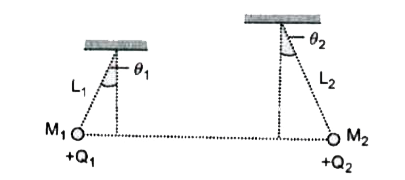Find the frequency of light which ejects electrons from a metal surface, fully stopped by a retarding potential of 3V. The photoelectric effect begins in this metal at frequency 6×1014s−1Solution in Kannada
105
1016
1.324×1015
none of these.
The correct Answer is:C
hv=Ek+w ∴Ek=hv−w
If Vs is retarding potential then
Ek=eVsandw=hv0
∴eVs=hv−hv0
or v=eVsh+v0
Given Vs=3V,v0=6×10−14s−1
∴ Required frequency v is
v=1⋅6×10−19×36⋅62×10−34+6×1014
v=1⋅324×1015 per sec.
Topper's Solved these Questions
- ELECTRONS & PHOTONSBOOK - MODERN PUBLICATIONCHAPTER - ELECTRONS & PHOTONSEXERCISE - MULTIPLE CHOICE QUESTIONS (LEVEL-II)
63 Videos
- ELECTRONS & PHOTONSBOOK - MODERN PUBLICATIONCHAPTER - ELECTRONS & PHOTONSEXERCISE - MULTIPLE CHOICE QUESTIONS (LEVEL-III)
9 Videos
- ELECTROMAGNETIC WAVESBOOK - MODERN PUBLICATIONCHAPTER - ELECTROMAGNETIC WAVESEXERCISE - RECENT COMPETITIVE QUESTIONS
4 Videos
- ELECTROSTATICSBOOK - MODERN PUBLICATIONCHAPTER - ELECTROSTATICSEXERCISE - RECENT COMPETITIVE QUESTIONS
39 Videos
Similar Questions
Maximum frequency of the photon produced by the union of a proton and a antiproton is (given : mp=1.67×10−27kg):
View SolutionEnergy required for the electron excitation in Li++ from the first to the third Bohr orbit is :
View SolutionThe speed of electromagnetic wave in vacuum depends upon the source of radiation
View SolutionTwo small spheres of masses M1andM2 are suspended by weightless insulating threads of lengths L1andL2 The spheres carry charges Q1andq2 respectively . The spheres are suspended such that they are in level with one another and the threads are inclined to the vertical at angles of θ1andθ2 as shown . Which one o fthe following conditions , if θ1=θ2 ?

View SolutionFind the frequency of light which ejects electrons from a metal surface. Fully stopped by a retarding potential of 3 V , the photoelectric effect begins in this metal at a frequency of 6xx10^(14)Hz . Find the work function for this metal. (Given h=6.63xx10^(-34)Js ).
View SolutionElectrons ejected from the surface of a metal, when light of certain frequency is incident on it, are stopped fully by a retarding potential of 3 volts. Photo electric effect in this metallic surface begains at a frequency 6xx10^(14)s^(-1) . The frequency of the incident light in s^(-1) is [h=6 x10^(-34) J-sec , charge on the electron = 1.6xx10^(-19)C ]
View SolutionWhen a metal surface is illuminated by a monochromatic light of wave-length λ, then the potential difference required to stop the ejection of electrons is 3V. When the same surface is illuminated by the light of wavelength 2λ, then the potential difference required to stop the ejection of electrons is V. Then for photoelectric effect, the threshold wavelength for the metal surface will be
View SolutionFind the frequency of light which ejects electrons from a metal surface , fully stopped by a retarding potential of 3.3 V. If photo electric emission begins in metal at a frequency of 8xx10^(14)Hz , calculate the work function (in eV) for this metal.
View SolutionStopping poential for the electrons emitted due to incidence of light on a metal is 3V. Determine the frequency of this light and also the work function for metal. Given, the threshold frequency for photoelectric emission from that metal is 6×1014Hz.
View Solutionधातु की सतह से इलेक्ट्रॉन निष्कासित करने वाले प्रकाश की वह आवृत्ति ज्ञात कीजिए जहाँ इलेक्ट्रॉन पूर्ण रूप से मंदन विभव 3V के द्वारा रुक जाता है। इस धातु में प्रकाश-विद्युत प्रभाव 6×1014s−1 की आवृति पर उत्पन्न होता है। इस धातु का कार्यफलन भी ज्ञात कीजिए।
View SolutionElectrons ejected from the surface oa a metal ,when light of certain frequency is incident on it ,are stoppeed fully by a retarding potenital of 3V. Photoelectric effect in this metallic surface begins at a frequency 6xx10^(14)s^(-1) .The frequency of the incident light in s^(-1) is [Planck's constant =6.4xx10^(-34) Js, charge on the electron =1.6xx10^(-19)C]
View SolutionFind the frequency of light incident on a metal surface if the photocurrent is brought to zero by a stopping potential of 2.6V . The threshold frequency for the metal surface is 5xx10^(14)//s .
View SolutionFind the frequency of light which ejects electrons from a metal surface stopped by a retarding potential of 3.3 V. if photoelectric emission begins in this metal at a frequency of 8×1014Hz, calculate the work function (in eV) for this metal.
View SolutionFind the frequency of light which ejects electrons from a metal surface , fully stopped by a retarding potential of 3.3 V. If photo electric emission begins in metal at a frequency of 8xx10^(14)Hz , calculate the work function (in eV) for this metal.
View SolutionWhen a metal surface is illuminated by a monochromatic light of wave-length lambda , then the potential difference required to stop the ejection of electrons is 3V . When the same surface is illuminated by the light of wavelength 2lambda , then the potential difference required to stop the ejection of electrons is V . Then for photoelectric effect, the threshold wavelength for the metal surface will be
View Solution
